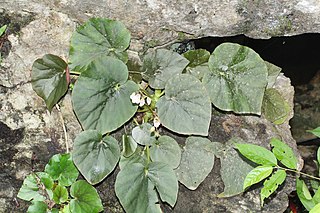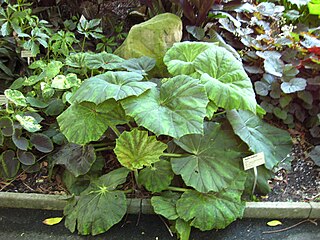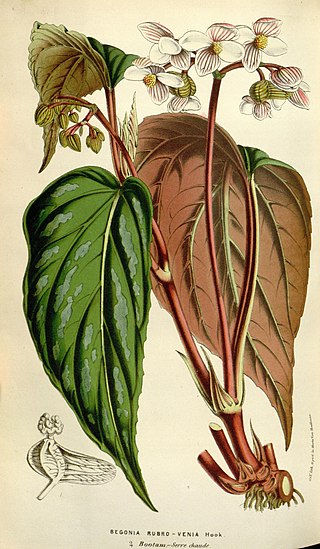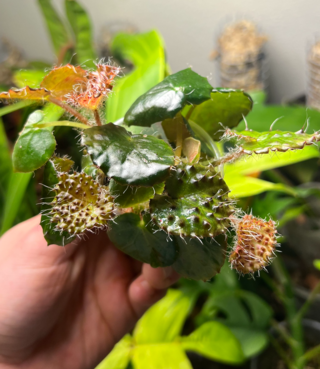
Begonia is a genus of perennial flowering plants in the family Begoniaceae. The genus contains more than 2,000 different plant species. The Begonias are native to moist subtropical and tropical climates. Some species are commonly grown indoors as ornamental houseplants in cooler climates. In cooler climates some species are cultivated outside in summertime for their bright colorful flowers, which have sepals but no petals.

Begoniaceae is a family of flowering plants with two genera and about 2040 species occurring in the subtropics and tropics of both the New World and Old World. All but one of the species are in the genus Begonia. There have been many recent discoveries of species in the genus Begonia, such as Begonia truncatifolia which is endemic to San Vincente, Palawan. B. truncatifolia is smaller in size than other species of the genus Begonia and this new species is proposed Critically Endangered by standards set by the IUCN. The only other genus in the family, Hillebrandia, is endemic to the Hawaiian Islands and has a single species. Phylogenetic work supports Hillebrandia as the sister taxon to the rest of the family. The genus Symbegonia was reduced to a section of Begonia in 2003, as molecular phylogenies had shown it to be derived from within that genus. Members of the genus Begonia are well-known and popular houseplants.

Begonia grandis, the hardy begonia, is a species of flowering plant in the family Begoniaceae. This herbaceous perennial has alternate, simple leaves on arching stems. The flowers are pink or white, borne in dichotomously branching cymes from late summer through fall in USDA U.S. Hardiness Zone 7. As the common name "hardy begonia" implies, it is winter hardy in some temperate regions.

Begonia cucullata, also known as clubbed begonia, is a species of the Begoniaceae that is native to South American countries of Argentina, Brazil, Paraguay, and Uruguay. A common garden plant and part of the section Begonia, it was described in 1805 by Carl Ludwig Willdenow (1765–1812). The specific epithet "cucullata" means "resembling a hood" or "hooded".

Begonia elnidoensis is an endemic species of Begonia discovered in El Nido, Palawan, Philippines. The species was compared to Begonia wadei, in that both species have thick-trunked stem, differing in the widely to very widely ovate or subtriangular leaves, with the latter having obliquely ovate leaves, 3-4 secondary leaf veins where the latter has 6 on each side of the midrib, with glabrous petioles compared to latter having puberulous to tomentose, an inflorescence measuring 20–40 cm in length compared to only 6–20 cm, and the differently-sized bracts and capsules.
Begonia gironellae is an endemic species of Begonia discovered in Tanabag, Puerto Princesa, in northern Palawan, Philippines. The species resembled Begonia cleopatrae, in that both species have widely ovate, variegated leaves, and fleshy hairs fused into a ring at the base of the leaf petiole. However, Begonia gironellae differed from B. cleopatrae due to its rosette habit with rhizome shorter to 5 cm long, with very congested internodes, widely triangular stipules, differently-sized lamina and bracts, and capsule with wider abaxial wing. Additionally, B. gironellae is a lowland species occurring in broadleaved seaside forests, while B. cleopatrae grows on hill forest at ca. 400m.
Begonia quinquealata is an endemic species of Begonia discovered in Salakot Falls, Napsan, Puerto Princesa City, in northern Palawan, Philippines. This species, along with B. suborbiculata Merr., are the only two known species in the Philippines with 5-winged capsules. Unlike any other member of Begonia sect. Baryandra, B. quinquealata is very distinctive for being a densely hairy herb with long creeping rhizomes. It differs also from B. suborbiculata in that it has thickly chartaceous, widely ovate leaves that have uniformly green upper leaf surface, densely velutinous, with denticulate leaf margin, outer tepals, and red scabrous ovary and capsules.
Begonia tabonensis is an endemic species of Begonia discovered in Tabon Cave, Lipuun Point, Municipality of Quezo, in Palawan, Philippines. This species resembles B. mindorensis Merr., widely ovate and uniformly green leaves, and inflorescence with sessile glands. However the two species differs on several characteristics: Begonia tabonensis have shorter petioles(10 cm long), smaller leaves(4-8 x 4–6.4 cm); deciduous, chartaceous, glabrous or very sparsely glandular bracts; and slightly pointed, crescent-shaped ovary wing; whereas, B. mindorensis have longer petioles(25 cm long), larger leaves(10-15 x 6-10 cm); persistent, coriaceous, densely glandular bracts; and acute, triangular ovary wing.
Begonia tenuibracteata is an endemic species of Begonia discovered in Salakot Falls, Napsan, Puerto Princesa City, in northern Palawan, Philippines occurring on mossy boulders along road cut in shaded, wet lowland forest. This species, along with B. mindorensis, produces the unusual, conspicuous, persistent bracts on the inflorescences. However, it sharply distinct from the latter due to its ovate to lanceolate bracts, which are hyaline, membranaceous, glabrous or with very sparse sessile glands where the latter have widely to depressed ovate bracts that are coriaceous, densely clothed with sessile glands. Additionally, B. tenuibracteata differs by the congested rhizomes with internodes only to 3 mm long; with shorter petioles ; velvety upper leaf surface; shorter inflorescence ; and fewer stamens (40–50); whereas B. mindorensis have 20 mm long rhizome internodes, petioles 10–25 cm long, glossy upper leaf surface, inflorescence over 35 cm long, and up to ca. 70 stamens
Begonia adamsensis is an endemic species of Begonia discovered in Adams, Ilocos Norte province, Luzon, Philippines occurring at an altitude of 308 m above sea level. The species broad-based leaves that are peltate, with a glabrous peduncle, an acuminate tip and nearly entire margin, resembled that of Begonia hernandioides. However, there are differences, in that B. hernandioides had red-colored stipule that is broadly ovate, the petiole and abaxial lamina is pubescent, and the peltate leaves are elliptic.
Begonia beijnenii is a species of flowering plant in the family Begoniaceae, native to the island of Palawan in the Philippines.

Begonia pavonina, or peacock begonia, is a species of rhizomatous plant in the family Begoniaceae. It is endemic to the dim understory in the montane forests of peninsular Malaysia.
The Philippine Taxonomic Initiative (PTI) is a private Philippine research institute and non-profit organization founded in 2018, located in the Philippines.

Begonia heracleifolia, the star begonia, is a species of flowering plant in the family Begoniaceae. It is native to Mexico and northern Central America, and has been introduced to Cuba, Hispaniola, Puerto Rico, and Trinidad and Tobago. A widespread species that is adapted to drought, it possesses considerable genetic and morphological variation, particularly in leaf shape and patterning.

Begonia sizemoreae is a species of flowering plant in the family Begoniaceae, native to Laos and Vietnam. It is popular in cultivation.

Begonia megaptera, the large winged begonia, is a species of flowering plant in the family Begoniaceae, native to Nepal, the eastern Himalaya, Assam, Bangladesh, and Myanmar. Very rare in its native habitat, it is cultivated as an ornamental and medicinal plant.

Begonia hatacoa is a species of flowering plant in the family Begoniaceae, native to Tibet, Nepal, the eastern Himalayas, Assam, Bangladesh, Myanmar, Thailand, and Vietnam. Its best-known cultivar is 'Silver'.

Begonia ferox is a species of flowering plant in the family Begoniaceae. Begonia ferox has been documented in Guangxi Zhuangzu growing on limestone outcroppings of the forest floor. It has a creeping growth habit, with leaves up to 19 cm long and 13 cm wide. When the leaves reach maturity, blackish-brown and hairy bullae with red tips emerge, up to 1.3 cm tall and .6 cm wide. It flowers from January through May, producing fruit April through July. Carpellate flowers are pinkish white, while staminate flowers are pinkish yellow, and the fruit is reddish-green.










